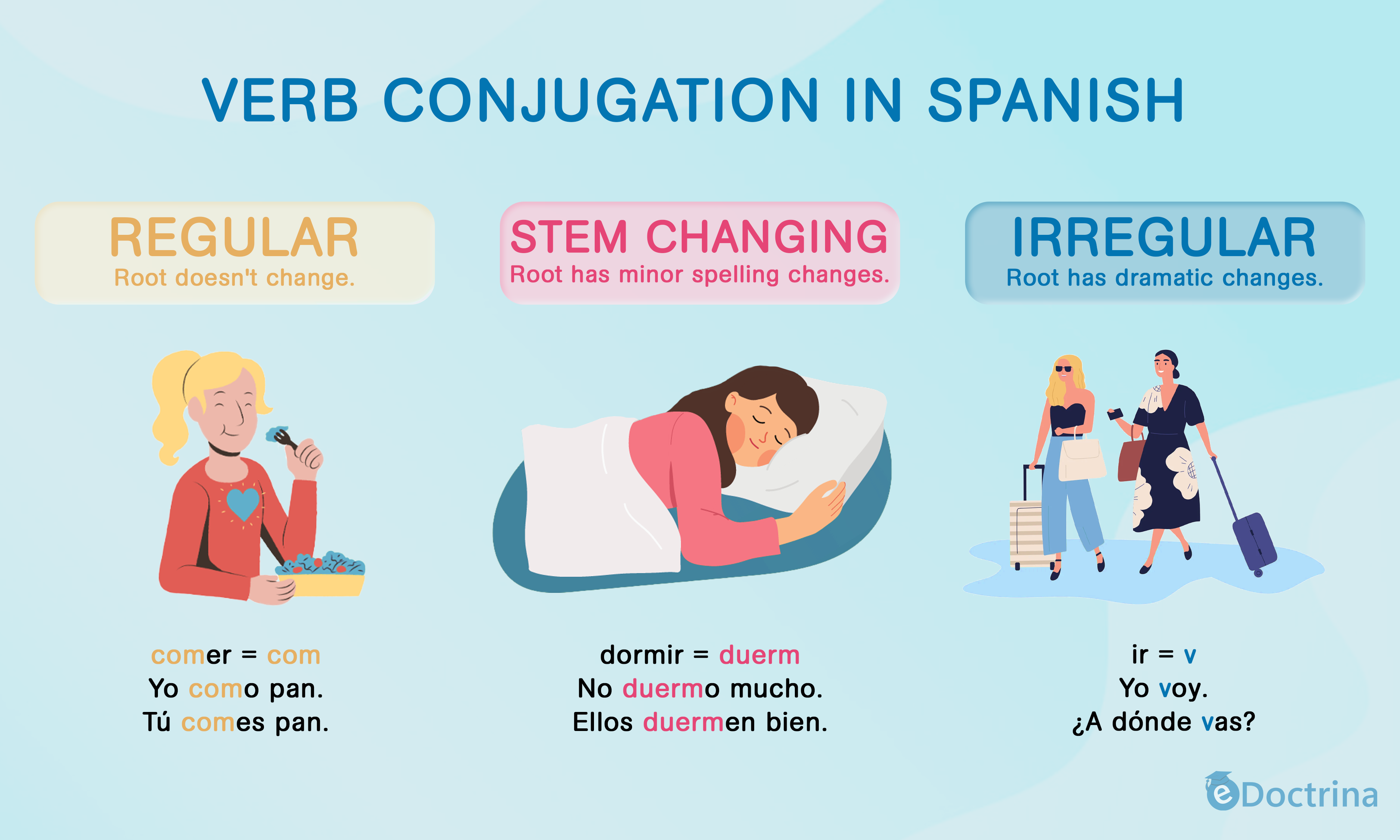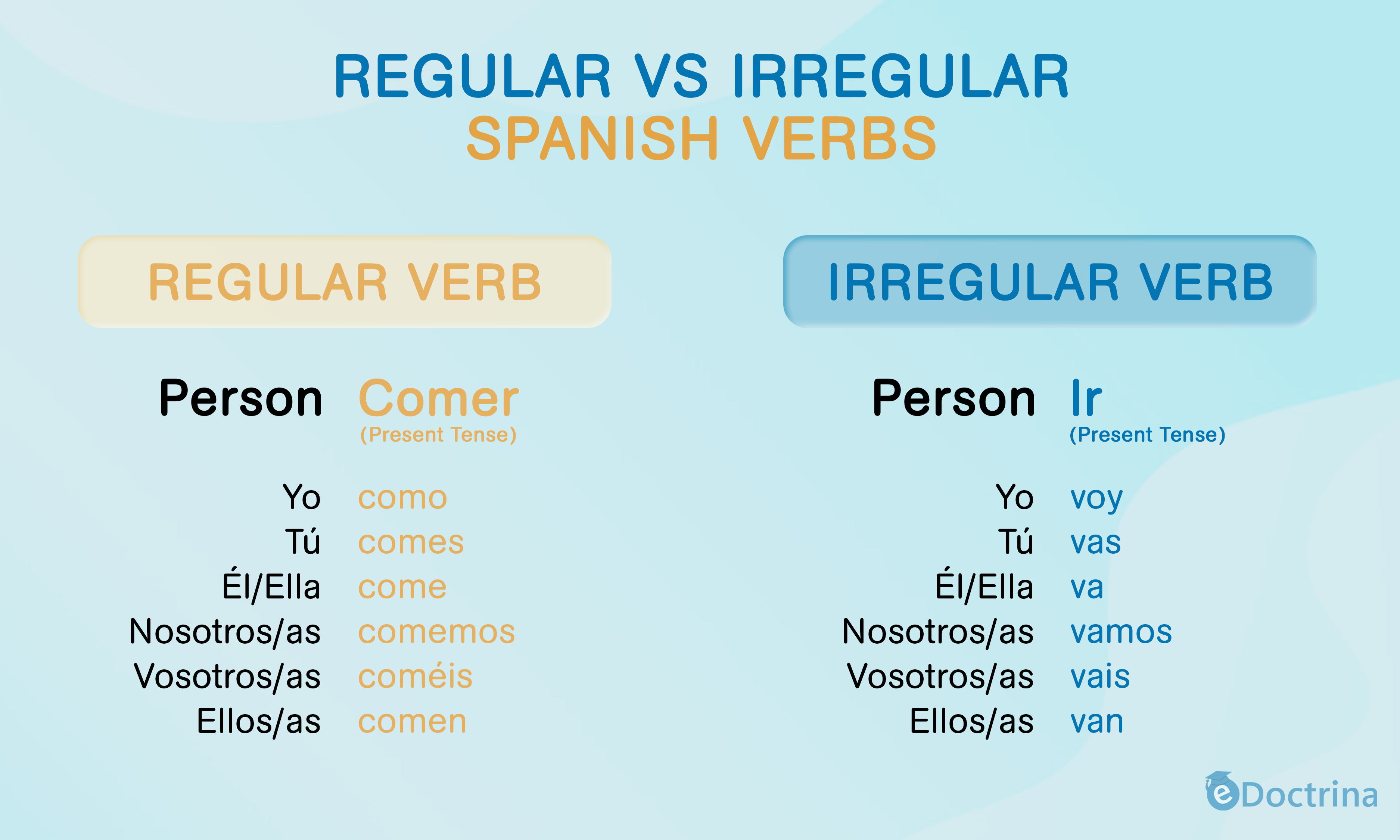A verb is a linguistic element that delineates an action or a state of being. In simpler terms, verbs articulate the actions or conditions of individuals or objects. Given their fundamental role in communication, I’ve assembled a collection of the most frequently used Spanish verbs.
Here is a preview of what you’ll discover:
List of Most Common Spanish Verbs
This collection is categorized into three groups:
- Regular: The root remains unchanged, and we apply the suitable endings for -AR, -ER, or -IR verbs.
- Stem-changing: The root undergoes a minor spelling adjustment to maintain pronunciation, and then regular verb endings are employed.
- Irregular: The root undergoes a change, and different endings may be used.

Presented below are Spanish verbs that it’s beneficial to be acquainted with:
| Verb | Translation | Type |
|---|---|---|
| Abrir | To open | Regular |
| Andar | To walk / To Be | Irregular |
| Apagar | To turn off | Stem-changing |
| Aprender | To learn | Regular |
| Asistir | To help / To attend | Regular |
| Ayudar | To help | Regular |
| Bailar | To dance | Regular |
| Beber | To drink | Regular |
| Buscar | To search | Stem-changing |
| Caer | To fall | Stem-changing |
| Cambiar | To change | Regular |
| Caminar | To walk | Regular |
| Cantar | To sing | Regular |
| Cerrar | To close | Stem-changing |
| Cocinar | To cook | Regular |
| Comenzar | To start | Stem-changing |
| Comer | To eat | Regular |
| Comprar | To Buy | Regular |
| Comprender | To understand | Regular |
| Conocer | To know / To meet | Stem-changing |
| Conducir | To drive | Stem-changing |
| Contar | To count / To tell | Stem-changing |
| Contestar | To answer | Regular |
| Correr | To run | Regular |
| Costar | To cost | Stem-changing |
| Creer | To believe | Stem-changing |
| Decir | To say | Irregular |
| Deber | To owe / Must | Regular |
| Dejar | To leave | Regular |
| Desear | To wish | Regular |
| Despertarse | To wake up | Stem-changing |
| Dormir | To sleep | Stem-changing |
| Empezar | To start | Stem-changing |
| Encontrar | To find | Stem-changing |
| Entender | To understand | Stem-changing |
| Entrar | To enter / To go in | Regular |
| Enviar | To send | Regular |
| Escribir | To write | Regular |
| Escuchar | To listen | Regular |
| Esperar | To wait / To hope | Regular |
| Estar | To be | Irregular |
| Estudiar | To study | Regular |
| Gustar | To like | Regular |
| Haber | To have | Irregular |
| Hablar | To speak | Regular |
| Hacer | To do / To make | Irregular |
| Ir | To go | Irregular |
| Jugar | To play | Stem-changing |
| Lavar | To wash | Regular |
| Leer | To read | Stem-changing |
| Levantarse | To get up / To wake up | Regular |
| Llevar | To take | Regular |
| Necesitar | To need | Regular |
| Oír | To hear / To listen | Irregular |
| Pagar | To pay | Stem-changing |
| Parar | To stop | Regular |
| Parecer | To seem | Stem-changing |
| Pasar | To pass | Regular |
| Pedir | To ask | Stem-changing |
| Pensar | To think | Stem-changing |
| Perder | To lose | Stem-changing |
| Poder | To can / To be able | Irregular |
| Poner | To put | Irregular |
| Preferir | To prefer | Stem-changing |
| Probar | To try / To taste | Stem-changing |
| Querer | To want | Irregular |
| Recordar | To remember | Stem-changing |
| Repetir | To repeat | Stem-changing |
| Saber | To know | Irregular |
| Sacar | To take out | Stem-changing |
| Salir | To leave / To exit | Irregular |
| Seguir | To follow | Stem-changing |
| Ser | To be | Irregular |
| Tocar | To touch / To play | Stem-changing |
| Tomar | To take | Regular |
| Tener | To have | Irregular |
| Trabajar | To work | Regular |
| Traer | To bring | Irregular |
| Usar | To use / To wear | Regular |
| Venir | To come | Irregular |
| Ver | To see / To watch | Irregular |
| Vestirse | To get dressed | Regular |
| Viajar | To travel | Regular |
| Vivir | To live | Regular |
| Volver | To return | Stem-changing |
Kindly observe: Certain verbs in this list may have a reflexive form, indicating that the subject performs the action upon itself. Nonetheless, it’s essential to note that not all Spanish verbs can take a reflexive form.
Basic Spanish Verbs
Within this section, you will discover pivotal verbs essential for Spanish conversations. It’s worth noting that the majority of verbs in this list exhibit irregularities.
Distinguishing Regular and Irregular Verbs
Regular Spanish verbs maintain an unchanged root, irrespective of the tense employed. Conversely, irregular verbs experience substantial changes in their root, and in certain instances, their endings may also be impacted.
Due to their adherence to a distinct conjugation pattern, regular verbs are comparatively more straightforward to grasp. The visual representation below illustrates the distinction between a regular and an irregular verb.

Ser – To Be
In Spanish, the verb “ser” is employed to depict individuals, objects, and locations, as well as to construct the passive voice.
| Person | Present | Preterite |
|---|---|---|
| Yo | Soy | Fui |
| Tú | Eres | Fuiste |
| Él / EllaUsted | Es | Fue |
| Nosotros | Somos | Fuimos |
| Vosotros | Sois | Fuisteis |
| Ellos / EllasUstedes | Son | Fueron |
For example:
Norma es doctora.
Norma is a doctor.
Las vendedoras fueron muy amables.
The salespeople were very nice.
Do you want to learn more?
Join the e-Doctrina Spanish community and learn basic Spanish communication in a carefully graded way for beginners.
Estar – To Be
Estar is also the counterpart of the English verb ‘to be.’ Nevertheless, in Spanish, estar is specifically employed to indicate location, emotional or physical states, and to establish the present progressive tense.
| Person | Present | Preterite |
|---|---|---|
| Yo | Estoy | Estuve |
| Tú | Estás | Estuviste |
| Él / EllaUsted | Está | Estuvo |
| Nosotros | Estamos | Estuvimos |
| Vosotros | Estáis | Estuvisteis |
| Ellos / EllasUstedes | Están | Estuvieron |
Presented below a few sentences:
La tienda está a dos cuadras.
The store is two blocks away.
Estuvimos ocupados todo el día.
We were busy all day.
Tener – To have
The verb tener is an irregular verb that expresses age, possession, and symptoms.
| Person | Present | Preterite |
|---|---|---|
| Yo | Tengo | Tuve |
| Tú | Tienes | Tuviste |
| Él / EllaUsted | Tiene | Tuvo |
| Nosotros | Tenemos | Tuvimos |
| Vosotros | Tenéis | Tuvisteis |
| Ellos / EllasUstedes | Tienen | Tuvieron |
As an example:
Eugenio tiene dos perros.
Eugenio has two dogs.
Lo siento, no tuve tiempo.
I’m sorry, I didn’t have time.
Kindly observe: Important to mention while tener is the equivalent of ‘to have’, it is not employed to construct compound tenses in Spanish. In such instances, we need to utilize the verb haber.
Haber – To Have
In Spanish, haber serves as an auxiliary verb utilized to create compound tenses, including the present perfect and past perfect tense.
| Person | Present | Preterite |
|---|---|---|
| Yo | He | Hube |
| Tú | Has | Hubiste |
| Él / EllaUsted | Ha | Hubo |
| Nosotros | Hemos | Hubimos |
| Vosotros | Habéis | Hubisteis |
| Ellos / EllasUstedes | Han | Hubieron |
Presented below some examples:
¿Has visto esta película?
Have you seen this movie?
No he comido nada.
I have not eaten anything.
Kindly observe: Important to mention the Spanish verb haber also possesses an impersonal form. “Hay” is employed to discuss existence.
Hacer – To Do / To Make
Utilize “hacer” to discuss the activities individuals engage in or create. Remember that “hacer” is one of the most frequently encountered irregular verbs in Spanish.
| Person | Present | Preterite |
|---|---|---|
| Person | Present | Preterite |
| Yo | Hago | Hice |
| Tú | Haces | Hiciste |
| Él / EllaUsted | Hace | Hizo |
| Nosotros | Hacemos | Hicimos |
| Vosotros | Hacéis | Hicisteis |
| Ellos / EllasUstedes | Hacen | Hicieron |
Some examples:
¿Qué hicieron ayer?
What did you guys do yesterday?
Elaine hace unas galletas riquísimas.
Elaine makes some delicious cookies.
Kindly observe: Utilize the impersonal form “hace” to discuss the weather in Spanish.
Ir – To Go
Similar to English, the verb “ir” in Spanish indicates that a person is heading somewhere. Additionally, it can be utilized to construct the near future tense.
| Person | Present | Preterite |
|---|---|---|
| Yo | Voy | Fui |
| Tú | Vas | Fuiste |
| Él / EllaUsted | Va | Fue |
| Nosotros | Vamos | Fuimos |
| Vosotros | Vais | Fuisteis |
| Ellos / EllasUstedes | Van | Fueron |
Examples:
¿A dónde fue tu mamá?
Where did your mom go?
Suzanne va a irse en unas horas.
Suzanne is leaving in a few hours.
Querer – To want
Employ this verb to articulate things or activities you desire to do. Given its various irregularities.
| Person | Present | Preterite |
|---|---|---|
| Person | Present | Preterite |
| Yo | Quiero | Quise |
| Tú | Quieres | Quisiste |
| Él / EllaUsted | Quiere | Quiso |
| Nosotros | Queremos | Quisimos |
| Vosotros | Queréis | Quisisteis |
| Ellos / EllasUstedes | Quieren | Quisieron |
Below are a few sentences:
¿Qué quieren hacer?
What do you guys want to do?
La niña no quiso ningún dulce.
The girl didn’t want any candies.
Gustar – To like
In Spanish, “gustar” is exclusively employed to discuss activities someone enjoys doing or to convey physical attraction towards someone.
| Person | Present | Preterite |
|---|---|---|
| A mí | Me gusta / gustan | Me gustó / gustaron |
| A ti | Te gusta / gustan | Te gustó / gustaron |
| A él / A ellaA usted | Le gusta / gustan | Le gustó / gustaron |
| A nosotros | Nos gusta / gustan | Nos gustó / gustaron |
| A vosotros | Os gusta / gustan | Os gustó / gustaron |
| A ellos / A ellasA ustedes | Les gustan / gustan | Les gustó / gustaron |
Here are some sentences:
A Gabriel le gustan los gatos.
Gabriel likes cats.
No nos gustó la película.
We didn’t like the movie.
Kindly observe: In Spanish, there are additional verbs similar to “gustar” that adhere to this conjugation pattern.
Poder – Can / To be able to
The irregular verb “poder” is utilized to discuss activities that individuals can or cannot do. To fully convey its meaning, it is necessary to pair it with infinitive verbs.
| Person | Present | Preterite |
|---|---|---|
| Yo | Puedo | Pude |
| Tú | Puedes | Pudiste |
| Él / EllaUsted | Puede | Pudo |
| Nosotros | Podemos | Pudimos |
| Vosotros | Podéis | Pudisteis |
| Ellos / EllasUstedes | Pueden | Pudieron |
For example:
¿Puedes hablar más despacio?
Can you speak slower?
Joseph no pudo arreglar su carro.
Joseph wasn’t able to fix his car.
Dar – To give
In addition to conveying the act of someone giving something to another person, “dar” in Spanish can also be employed to discuss the emotions that something evokes in you.
| Person | Present | Preterite |
|---|---|---|
| Yo | Doy | Di |
| Tú | Das | Diste |
| Él / EllaUsted | Da | Dio |
| Nosotros | Damos | Dimos |
| Vosotros | Dais | Disteis |
| Ellos / EllasUstedes | Dan | Dieron |
Here are some examples:
Juan me dio una manzana.
Juan gave me an apple.
¿Cuánto tiempo les dieron?
How much time did they give you?
Kindly observe: This verb adheres to the same conjugation pattern as ‘gustar’ when expressing emotions. As a transitive verb, “dar” functions with both indirect and direct object pronouns.
Extra: Strategies for Mastering Verbs
Spanish verbs play a crucial role as they enable you to articulate actions. Here are some simple tips to enhance your proficiency in this vocabulary:
- Prioritize key verbs for everyday conversations: Instead of attempting to memorize an extensive list, focus on selecting verbs that align with your daily communication needs. The verbs outlined in this article serve as a valuable starting point, addressing common situations.
- Engage in consistent practice: Upon learning a new verb, it is essential to practice it extensively. Incorporate it into your conversations whenever possible. Alternatively, you can enhance your skills by crafting sentences in various tenses, employing flashcards, or practicing verb conjugation.
- Familiarize yourself with opposite verbs: Embrace the Opposite Method, a simple concept based on our brain’s adeptness at thinking in opposites (blanco, negro, arriba, abajo). When acquiring a new verb, invest time in learning its antonym, as this knowledge is likely to prove useful – “Prende la luz y apágala cuando termines.” Recognizing these connections can significantly enrich your learning journey.

